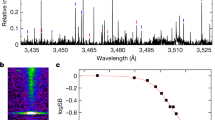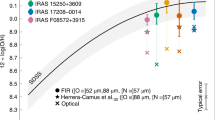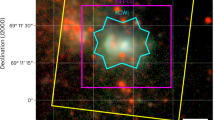Abstract
DIFFUSE interstellar absorption bands at 4,430, 4,760, 4,890 and 6,180 Å have been assigned to crystal-field transitions of octahedrally and tetrahedrally bonded ferric ions in an iron oxide1–3. The optical absorption spectra of terrestrial iron bearing minerals4–6 often comprise, in addition to the crystal-field bands, a broad absorption (half-width 3,000 cm−1) in the range 14,000–18,500 cm−1 (715–540 nm) marking Fe2+3dt2 → Fe3+3dt2 intervalence charge transfer, the cations being located at the centres of adjacent edge-sharing octahedra. Here, I suggest that a discontinuity at ∼ 1.6 µm−1, which I see as a minor feature on the mean extinction curve7 for several reddened stars, represents Fe2+→Fe3+ charge transfer absorption in interstellar grains. A shallow emission feature observed at ∼ 1.8 µm−1 in the reddening curve for another group of stars has been interpreted8 as a dip lying between two absorptions centred at ∼ 1.5 and ∼ 2.4 µm−1.
This is a preview of subscription content, access via your institution
Access options
Subscribe to this journal
Receive 51 print issues and online access
$199.00 per year
only $3.90 per issue
Buy this article
- Purchase on Springer Link
- Instant access to full article PDF
Prices may be subject to local taxes which are calculated during checkout
Similar content being viewed by others
References
Huffman, D. R., Astrophys. J., 161, 1157 (1970).
Manning, P. G., Nature, 227, 1121 (1970).
Manning, P. G., Nature phys. Sci., 239, 87 (1972).
Robbins, D. W., and Strens, R. G. J., Chem. Commun., 508 (1968).
Faye, G. H., and Nickel, E. H., Can. Mineral., 10, 35 (1969).
Faye, G. H., Manning, P. G., Gosselin, J. R., and Trembley, R. J., Can. Mineral., 12, 370 (1974).
Whittet, D. C. B., Van Breda, I. G., and Nandy, K., Nature phys. Sci., 243, 21 (1973).
Hayes, D. S., Marko, G. E., Radick, R. R., Rex, K. H., and Greenberg, J. M., Interstellar Dust and Related Topics, 83 (Internat. astr. Un., 1973).
Lohr, L. L., Coord. Chem. Revs, 8, 241 (1972).
McClure, D. S., J. chem. Phys., 39, 2850 (1963).
Verwey, E. J. W., and Heilmann, E. L., J. chem. Phys., 15, 174 (1947).
Deer, W. A., Howie, R. A., and Zussman, J., Rock-forming minerals, 5 (Longman, London, 1962).
Manning, P. G., Can. Mineral., 9, 678 (1969).
Mason, B. H., Principles of geochemistry, 22 (Wiley, New York, 1966).
Harris, J. W., Nature, 223, 1046 (1969).
Nandy, K., Seddon, H., Wolstencroft, R. D., Ireland, J. G., and Wickramasinghe, N. C., Nature, 218, 1236 (1968).
Author information
Authors and Affiliations
Rights and permissions
About this article
Cite this article
MANNING, P. Origin of broad interstellar feature at 1.6 µm−1. Nature 255, 40–41 (1975). https://doi.org/10.1038/255040a0
Received:
Accepted:
Issue Date:
DOI: https://doi.org/10.1038/255040a0
This article is cited by
-
CO adsorption and the optical properties of interstellar grains
Astrophysics and Space Science (1983)
Comments
By submitting a comment you agree to abide by our Terms and Community Guidelines. If you find something abusive or that does not comply with our terms or guidelines please flag it as inappropriate.



